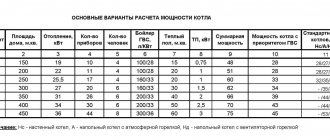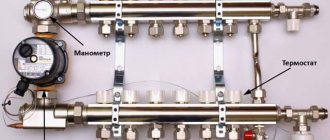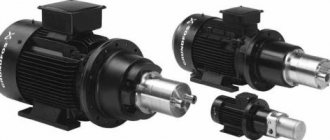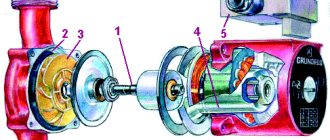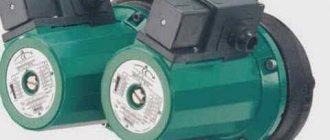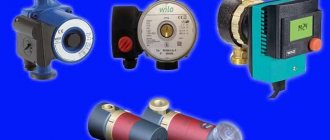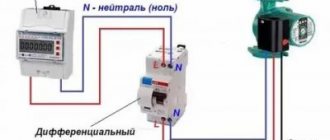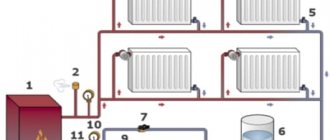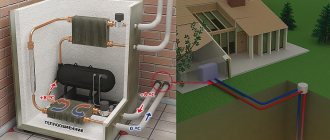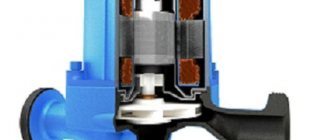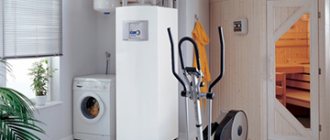In order for the water supply system to work uninterruptedly, the main thing is to choose the right pump.
Pumps are used to supply water from a well or well or to recirculate it. In order for the system to work efficiently and uninterruptedly, and also in order not to overpay for a model with excessive characteristics, they need to be selected. Let's consider how to calculate a pump for water supply and select the parameters of these units.
Water pipes
In addition to the calculation method in the usual way, we will also give several examples of working with online calculators.
First, let's look at cold water supply systems, that is, regular plumbing, then we'll touch on hot water supply (abbreviated as DHW). Moreover, we will not talk about the choice of powerful pumps that are installed at water supply network stations - our article is about the water supply of small houses and cottages.
If the house is connected to a central water supply, then in most cases the necessary pressure is created at water supply stations or water towers. Therefore, pumps in this case are usually not needed. The exception is high-rise buildings, where normal pressure from the water supply does not allow water to be supplied to the uppermost floors - booster pumps are installed there.
Interesting fact. Columns of water 10 meters high create a pressure of one atmosphere (0.1 MPa), so the difference in pressure on the first and third floors is approximately this amount. If we take for example the tallest building in the world, the Burj Khalifa, with a height of 828 meters, then in order for the water to even reach the top floor, a pressure of about 84 tons of atmospheres is needed. Naturally, no pipes can withstand it, so the pumps are installed in stages across several floors.
To supply water to such buildings, the pressure created in the water supply is not enough; booster pumps are required
With an autonomous water supply system, you cannot do without pumps. As a rule, either conventional (surface) or submersible (deep) pumps are used. With very rare exceptions, their drive is electric.
The choice depends on the specific situation or the wishes of the customer. Let's look at how they differ and the most important characteristics that we will need when carrying out the calculation.
Conventional pumps
Conventional (surface) pump for water supply
Centrifugal pumps are almost exclusively used to supply water. In them, the liquid is captured by the blades in the center of the rotating impeller and is thrown due to centrifugal force to its perimeter, where the pressure pipe is located. In the center where water is taken, a vacuum is naturally created.
Attention. When starting such a motor without water (dry running), without encountering fluid resistance, the wheel, especially on powerful large pumps, can spin very quickly and break off the shaft or be damaged in other ways. Therefore, this situation is prevented by proper startup, installation of check valves at the inlet (they prevent water from draining from the housing) and the use of special automation.
Typically, two types of pumps are used - with an oil seal on the drive shaft and more modern ones with a floating rotor.
- In the first, the impeller drive shaft passes through the housing (scroll) in which the impeller rotates. This place is sealed with oil seals or mechanical seals. The shaft can rest on its own bearings, which are located in the console and connected to the electric motor through a coupling.
- Another option for such a pump is a monoblock. In it, the impeller is mounted directly on the impeller. The first type is more reliable and easier to maintain and repair. The second one is more compact.
- Pumps with a floating rotor do not have seals at the shaft passage. In it, as the name implies, the rotor of the electric motor is located in a housing volumetrically connected to the volute. The stator electromagnets create torque through the wall, the water cools the rotor and lubricates its bearings.
Such pumps are compact and reliable. The downside is the difficulty of repair - you can’t simply replace the motor; you need to completely disassemble the pump.
In addition, standard electric motors cannot be used in such a unit. However, they rarely fail and do not require maintenance throughout their entire service life (many manufacturers guarantee this).
Pump characteristics
Now let's move on to the most important thing.
The type of conventional pump selected for your off-grid water supply system affects the following:
- cost of installation of an autonomous water supply system;
- costs of its operation;
- frequency of maintenance;
- complexity and cost of installation;
- dimensions of the pump installation site.
Otherwise, when calculating, you need to focus on more important characteristics:
- Suction depth : It determines the mark below the pump from which it can draw water. It is usually determined in meters.
- Head : It is expressed in terms of the outlet pressure of the pump.
- Performance : how many cubic meters the pump can pump per hour.
You also need to pay attention to such figures as energy consumption (power); with equal characteristics, it is advisable to give preference to more economical models. However, the price for them is usually higher, so it is advisable to calculate how long it will take for a more expensive model to pay for itself (however, this is an economic calculation).
If the service life is less than the payback period of an expensive pump, then, most likely, you should not overpay, but buy a pump that is more power-hungry.
Deep well pumps
Deep well pumps
They differ from ordinary ones in that they are immersed in water, that is, in the casing of a well, a well, or even an ordinary body of water. By design, they differ from conventional pumps in such features.
- Most often, they have not one impeller, but several, up to a dozen, located one behind the other. The suction of one is connected to the output of the next (labyrinth system).
- If conventional pumps most often have a horizontal shaft arrangement, then deep-well ones are always vertical. This is due to their location in well casing pipes of limited diameter, which are also vertical (installation in a well or reservoir is a special case to which designers pay little attention).
- Electric motors are also of a special design. They do not have casing fins, as they are cooled by water.
Attention. You cannot run a deep-well pump not submerged; it is not designed for such a mode and can immediately burn out.
Also, the motors of these units have more elongated dimensions along the axis with a smaller diameter. This is also related to installation in wells.
In addition to centrifugal pumps, vibration and submersible pumps are also used for small water supply systems. This, for example, is the well-known “Rucheek” (pictured below). According to the principle of operation, it is similar to ancient piston pumps (including bicycle ones), although the piston stroke is shorter, the oscillation frequency is higher (that’s why it is called vibrational), and an electromagnet is used for the drive.
Despite the slightly worse characteristics compared to centrifugal deep-well pumps, everything that is said in our article about them fully applies to the “Rucheyok” and its analogues.
Brook type pump
Characteristics of deep-well pumps
The definitions of the characteristics of deep-well pumps are exactly the same as for conventional ones. The only difference is that the suction is not regulated for them, since the vacuum at the inlet is not important, the unit is already surrounded by water.
But many deep-well pumps have an order of magnitude greater pressure than conventional ones. When installed in a deep well, they must immediately overcome the pressure in a long riser pipe, and then create the required pressure in the water supply.
They are also considered to be somewhat more economical due to water cooling. But this advantage is minimal over pumps with a floating rotor. They also use a similar principle, although the stator does not have contact with the liquid on all sides. Completely washing the pump with water gives minimal savings of a fraction of a percent.
Which pump to choose: deep or surface (regular)
Quite a difficult question - let’s compare their advantages and disadvantages.
Conventional pumps
Pros:
- They are easier to mount on a surface.
- Inspection, maintenance and repair are also easier.
- Typically, conventional pumps are cheaper.
Minuses:
- A place or room for installation is required.
- Protection against dry running is required.
- In terms of suction depth, they are inferior to the pressure of deep-well pumps, so they cannot be used to draw water from deep wells.
Deep well pumps
Pros:
- Can work in deep wells.
- They do not require arrangement of installation sites. Water from the riser pipe can be directly supplied to the water supply system.
- If the pump is immersed below the minimum water level in a well, well or reservoir, it is protected from “dry running”.
Minuses:
To remove deep-well pumps, it is often necessary to use lifting mechanisms
- When installed in wells deeper than 10 meters, removing the pump along with the water-lifting pipe for inspection and repair with your own hands is often impossible; lifting mechanisms must be used.
- If for some reason the pump was torn off from the pipe and insurance (unless, of course, you forgot about the latter), it is quite difficult to get it out.
Interesting fact. The author of this article had to remove the accidentally missed pump using a special trap. After it was “saved,” five more units, mostly almost completely destroyed by corrosion, were pulled out of the well, which were lost by previous operators over the more than thirty-year history of the engineering structure.
- The power cable supplying the unit must be protected from exposure to ambient water. Often its breakdown, which occurs from damage to the insulation, leads to the need to remove the pump, and this, as we said above, is difficult.
Therefore, we will give one piece of advice: if you do not have a very deep well, or even more so, it is just a well and there is space for installation on the surface, you should still give preference to conventional pumps. They are cheaper and easier to operate.
Often, as an advantage of conventional pumps over deep pumps, they also consider the fact that the deep pump is protected from contamination only by a mesh filter on the casing, while the regular one can be additionally protected by multi-stage filters on the suction.
This is a false fact:
- Any water purification installation works stably only with sufficient pressure, that is, it must be installed after the pump.
- Pumps for water supply (no matter deep or ordinary) are designed for the presence of impurities in the source water, and they do not significantly reduce their service life. Of course, if you do not pump a mixture of sand and water directly, the latter effectively retains the mesh filter.
Now, having dealt with the choice of pump by type, let’s move on directly to choosing it by characteristics.
A little about pressure units
Pump specifications for measuring pressure can use more than just Pascals
Everyone knows the usual atmospheric pascals well from school, but less well-known units may also be present in the pump characteristics.
- A meter is a meter of a column of water. As mentioned above, it is equal to one tenth of the atmosphere.
- A bar is a non-systemic unit (but approved for use in our country) approximately equal to one atmosphere.
Attention. You may also come across such an incomprehensible term as “excessive pressure”. Don’t pay attention, almost all instruments and calculations for water supply use the term “pressure” to mean this.
The absolute pressure will be one atmosphere higher, that is, the pressure that already exists on the surface of the earth, where water supply systems operate. Even in a glass, water is under an absolute pressure of one atmosphere.
Selection (calculation) of a pump for water supply according to characteristics
Let’s make a reservation right away: we do not calculate water supply pumps using hydraulics, that is, we do not take into account the resistance to water flow in pipes and on shut-off elements. For small water supply systems of a private home, it is scanty, and the calculations are complex.
Note. Some pumps have parts that are made of materials that, according to sanitary and hygienic standards, are unacceptable for use in water supply networks. Therefore, you need to choose models that are approved for these purposes.
To select a pump we need to take several steps, the instructions will be as follows.
Choosing performance
Pump performance depends on water flow per unit time
The first thing you need to focus on is water consumption per person per day, it is 400-500 liters. If you have a storage tank of sufficient capacity (like a water tower), you can follow these steps.
- We multiply the average consumption by the number of people living in the house (for example, an average family of four), plus one person for possible guests (if you have them): 500x5 = 2500 liters.
- Divide by the number of hours per day: 2500:24 = 104 l/h, this is the average hourly consumption.
- Since it is desirable that the pump does not work constantly in order to avoid overheating and failure, we additionally divide it by the time of its operation. It is usually recommended that the operating time should not exceed 80%, that is, we divide by 80:100 = 0.8, we calculate: 104:08 = 130 l/h. We take this characteristic for the pump as well.
But, as a rule, storage tanks are not used in water supply systems of small houses. The most common scheme is a combination of a pump and a small-sized tank (hydraulic accumulator), as well as automation systems. Usually they buy an already assembled block of these devices from sellers, and in everyday life (which is not entirely true) they call them pumping stations.
In this case, calculating by daily consumption is not entirely correct. The pump does not operate constantly, feeding a large storage tank (it does not need to be used as a hydraulic accumulator from a small container), but only during water consumption.
So, for example, if mom decides to wash the dishes, dad decides to wash his hands after repairing the car, one child takes a shower, and the other uses the toilet, and the washing machine is working, then the water consumption may be much more than the daily average. Therefore, the calculation of the water supply pumping station and similar systems should be carried out based on these peak analyzes.
To do this, we count all the available water fixtures in the house. Then we take their hourly expenses. To do this, you can use the table in Appendix 2 to SNiP 2.04.01-85. It is given below.
Water consumption and other characteristics of plumbing fixtures
Next, we make a list of all plumbing fixtures and their hourly costs. Moreover, we take not only cold water, but the total flow rate, because hot water is heated cold water, which is taken from the same water supply system.
Advice. In order not to count manually, it is easier to use Excel, as in the table below.
| Device name | Hourly water consumption, l/h | Number of appliances in the house | Their total consumption |
| Sinks with mixer tap | 60 | 5 | 300 |
| Washing | 50 | 1 | 50 |
| Bath | 300 | 1 | 300 |
| Foot bath with mixer | 220 | 1 | 220 |
| Shower with deep tray and mixer tap | 115 | 2 | 230 |
| Hygienic shower (bidet) | 75 | 1 | 75 |
| Toilet with cistern | 83 | 2 | 166 |
| Urinal | 36 | 2 | 72 |
| Watering tap | 1080 | 1 | 1080 |
| Total | 2493 |
As a result, we obtained the maximum water flow rate in the water supply of your home - 2493 liters per hour. This figure is even a little overestimated, since it is unlikely that all devices will be turned on at the same time; it can be reduced by a factor of 0.9-0.8. We get: 2493x0.8=1994 l/h. True, if the house is small and there is only one kitchen and bathroom, this is not worth doing.
Based on our resulting peak water flow per hour, we will select the pump performance in the future.
Selecting the pressure
Tall cottages require more pressure
Here the choice depends on whether it is a deep-well pump or a regular one.
- For a conventional pump, everything is as simple as possible: according to standards, the pressure in the water supply should be in the range of 0.05-0.5 MPa, that is, from half to five atmospheres. As practice shows, for normal operation of washing machines, dishwashers and other household appliances, it is desirable that the pressure is not less than 1 atmosphere, i.e. 0.1 MPa, so we will choose a pump with exactly this pressure.
If you have a cottage with more than three floors (which is rare), then you need to make sure that there is normal pressure at the top. With a standard ceiling height of about 3 meters, there will be no pressure on the fourth floor, so we add 0.1 MPa.
That is, in most cases, when selecting a pump for water supply, a pressure of 1-1.5 atmospheres (0.1-0.15 MPa) is sufficient.
- When choosing an option with a unit installed in a well, calculating the water supply pump for pressure becomes more complicated, but not much - you just need to take into account its immersion mark. That is, if water is taken from a depth of 15 meters, to the pressure calculated, as in the previous case, we add 1.5 atmospheres (15:10 = 1.5) or 0.15 MPa (15:100 = 0.15 ). We consider: 0.15 + 0.1 = 0.25 MPa, and we will be guided by this figure when choosing a specific pump model.
Suction depth (suction)
The deeper the well, the greater the pump suction should be.
The easiest parameter to select. For deep-well pumps it is not needed and is not described in the characteristics at all, since water is taken from the level at which the pump is located.
In the case of a conventional surface pump, it is necessary that this characteristic be slightly greater than the difference between the elevations of the intake and the location of the pump. The reserve is needed for unforeseen situations, for example, during a drought the level will drop and the intake will have to be lowered.
It is easy to select, for example, the pump is located at ground level, and water is drawn from a depth of 10 meters. This means that the suction must be more than 10 meters.
It is not worth giving a multiple supply; if the intake is located at a depth of 1 meter, then you should not take a pump with a suction depth of 15, 3-5 is enough. This is due to the fact that the greater this characteristic, the more complex and expensive the pump.
Direct selection
When all the parameters are known, you can select a pump or station from price lists and directories. You don’t even have to select a model yourself. Almost all sellers' websites have filters into which we enter the necessary characteristics, then a list of the most suitable models is displayed on the screen.
For example, to make a selection on a website, you only need to take a few steps. We need a surface pump with a capacity of 1.5 liters per minute with a lift height (suction) of 5 meters and a pressure of 1.5 atmospheres (15 meters). Let's do the following.
- On the tab at the top, click on the “surface pump” tab.
Pump type selection
- Then you can enter the necessary parameters in the filter on the right of the page. Additionally, you can select the price range, brand, power, drive type (electric motor, internal combustion engine), etc. If the calculation of the water supply station was carried out, then you can find it.
Entering pump parameters
- After this, we press enter, and our page displays units that meet the specified characteristics.
Pumps selected according to specified parameters
- Additionally, you can select the order in which the pumps will be displayed on the page. That is, options are possible for increasing or decreasing price, popularity, or immediately newer or older models and vice versa. To do this, click on the buttons at the top of the page.
Selecting the order in which models are displayed on the page (sorting)
Content
Submersible pump installation diagram
The possibility of installing this or that equipment is calculated at the planning stage of a hydraulic structure. If the depth of the aquifer is more than 9 m, then only submersible pumps or surface pumps, additionally equipped with an injector, can be installed. Based on the plans for the equipment, you need to decide what pipe diameter is suitable for a particular well. Drilling costs depend on this. The narrower the pipe, the cheaper it will cost to build a source.
Most often, wells are built with a diameter of 60, 90, 108 or 125 mm. The smallest possible is 50 mm. However, it is suitable for installing surface pumps with external ejector. It is believed that the diameter of the pipe affects the productivity of the source. This is not entirely true. It is not the size of the structure itself that directly affects, but the presence of a filter. Over time, the filter becomes clogged, requires repair and can limit the productivity of the water intake.
Filters for large-diameter structures are necessary because the pipe is not installed tightly in the ground, because The drill diameter is larger. After drilling, the space behind the production casing is filled up, but it is impossible to compact the soil to its full depth and, in order to protect the water from contaminants and quicksand, a filter must be installed. This is especially true for water intakes with plastic columns.
Pump performance graph
To accurately determine the desired pipe diameter, you first need to select the material from which it should be made, because... this may affect the choice of design of the source itself. Three types of pipes are commonly used:
The final decision can be made after an objective assessment of the depth of the formation, construction technology, and soil structure. The main criterion for choosing a material is price. No matter how much the advantages and disadvantages of different pipes are discussed, we are still talking about cost - purchase, operation, repair, etc.
Steel remains one of the most reliable and sought-after materials
The most reliable are still black steel pipes. They do not emit harmful substances into the water, like galvanized ones; do not burst like plastic ones; not as thick as asbestos-cement ones. At the same time, steel lasts up to 50 years, and ferric iron, which can appear in water over time, is easily removed by filters and settling.
However, steel becomes more expensive every year, and people are looking for other options. The cheapest of them seems to be plastic. Plastic pipelines are really convenient, lightweight, airtight, but do not withstand soil shifts. Therefore, if plastic is chosen, it is advisable to build a well from two columns: a plastic production column and a steel casing. Having decided, you can calculate the required diameter of the pipe and, accordingly, the pump housing.
By reducing the cost of well construction, you can achieve exactly the opposite effect. The smaller the diameter of the pipe, the more difficult it is to select a pump for it. In addition, maintaining a narrow well is more expensive and its potential service life is reduced. Experts do not recommend building structures with a diameter of less than 4 inches; the optimal option is 110 mm or more.
When choosing submersible equipment, it is easy to see that three-inch pumps are more expensive than four-inch ones, and their performance is usually lower. Of the three-inch devices, Grundfos are considered the best. The range of four-inch models from reliable manufacturers is much wider. And a comparison of prices for drilling 90 and 110 mm wells shows that the difference is not so great as to create problems with the choice of pump and future maintenance of the hydraulic structure.
Cables for well pumps
When choosing a model of water-lifting equipment, pay attention to the diameter of the cable for the well pump. You should focus on the strength of the material, because the weight of a pipe filled with water can reach 80 kg or more. Nylon, nylon and PVC cables are in greatest demand. They are durable and do not corrode, unlike their steel counterparts. The disadvantage of synthetic materials is their gradual stretching. Many well owners play it safe and fold the cable in half or three times when installing the pump.
We recommend similar articles
- Arranging a caisson for a well with your own hands from concrete and brick or installing a ready-made module
- How to make an Abyssinian well with your own hands - a simple solution to the issue of water supply to the site
- Construction of a country water supply system with a submersible pump: diagram and equipment
Selecting a pump for domestic hot water
Hot water recirculation pump
The selection and calculation of pumps for hot water supply is not much different from the selection of units for cold water supply. But you need to take into account some features.
- When calculating the amount of water per person, we take the norm to be 140-150 liters per day.
- To calculate peak flow rates for plumbing fixtures, you can use the same table from SNiP 2.04.01-85, which is given above - in addition to the cold water flow rate, it also shows the hot water flow rate, which is naturally less.
- When choosing a pump pressure, you need to focus on the pressure in the cold water supply. These numbers must be equal, otherwise, with faulty mixers, hot water can be squeezed into cold water and vice versa; the network in which the pressure is higher will displace liquid from the pipelines where it is lower.
- The depth of lift (suction) is not important to us. Water is supplied to the pump inlet under pressure.
- Not all pumps can operate at elevated temperatures. You need to choose only models designed for hot water supply networks.
Surface pump for well
Devices of this type are not intended for pumping water from a well, because the maximum depth that a surface pump can handle is 9-10 meters according to the passport and 6-7 meters in practice. In addition, they are sensitive to sand and are quite noisy. Surface pumps are used to pump water from an Abyssinian needle well; they are not used in the construction of a regular well. The price of such a device is at the level of a cheap centrifugal pump, and a surface pump has no advantages over it.
Selecting a pump using an online calculator
If you want to make it easier to calculate a water supply pump, you can use online calculators. Some of them make the calculations even overly accurate, while some, on the contrary, contain many errors. Some give only parameters according to which you need to independently select a model from catalogs, and some immediately give out the pump model.
Let's look at a few examples of working with these calculators.
It should also be noted that most often the result is a specific pump that the site owners produce or sell. Therefore, when using a calculator, you may not choose the most efficient or reliable model. The choice is yours.
Calculator on the WPCALC website
It is available at the link: https://wpcalc.com/moshhnost-nasosa-dlya-skvazhin. The calculator calculates only parameters and only for deep well pumps.
We work with it as follows:
- We immediately go to the page with a short introduction that describes deep-well pumps and their purpose.
Login to the calculator website
- Then scroll down a little and go directly to the calculator.
Calculator
- We enter the parameters: well depth, distance to water, area of the site and the number of people living in the house.
Entering parameters
- Next, enter the number of plumbing fixtures in the house.
Here we enter the number of plumbing fixtures in the house
- Click on the green “Calculate” button.
"Calculate" button
- And using it we read the calculation parameters. It's just performance and drive. You need to choose the pump yourself.
Calculation results
It should be noted that this is not the most reliable calculator. It does not take into account what pressure we want to set in our DHW system, and also (verified) does not take into account peak discharges.
Calculator on the website
Another simple calculator at: https://gidrotehnica.ru/calk1/. Unfortunately, it does not give out parameters, but selects specific pumps. But it also calculates the power of the pump for water supply, and it is easy to work with.
- Open the page with the calculator.
Calculator main page
- Then enter the distance to the water surface in the well, for example 15 meters.
Enter the distance to the water surface
- Select the minimum diameter of the casing pipes by checking the corresponding button. We chose over 120mm.
Selecting the casing diameter
- Then we select the type of system, more precisely the control, manual or automatic, also checking the box. We chose the first one.
Selecting a system type
- Then, under the “Quick selection” item, we determine the water consumption from three options depending on the number of people living in the house. We chose more than three people. Of course, the accuracy of the calculation is low, since between three people and a large family the difference in water consumption is significant.
Selecting water flow
- Next, you can check the box next to “Detailed selection” and indicate in the window below the maximum height of the plumbing fixture in the house. This is necessary for a more accurate calculation of pressure. For example, enter 4 meters.
Waters of the maximum height of plumbing fixtures in the house
- Next, click the “Search for Equipment” button or just the “Enter” key on the computer.
Equipment search button
A page is displayed on the screen in which the table shows the recommended types of pumps and their parameters. By clicking on the name of the pump you can go to its page in the online store catalog
Page with selected equipment
Service life of centrifugal pumps
When talking about deep well pumps from a particular manufacturer, it is very common to mention their service life.
For example, inexpensive pumps last 5-7 years, and high-quality products last 10-15 or more. But in reality everything is not so simple. The service life of a well pump, which works in tandem with pressure automation, depends not only on the pump itself, but also on the serviceability of the automation itself. and it requires periodic maintenance. Ideally, everything looks like this: when you open the tap, water starts flowing from the tank, the well pump stands idle, the pressure gradually decreases, and only then the pump turns on, which pumps water back into the tank. You have already closed the tap, but the pump continues pumping until the tank is completely filled and then turns off. If, for example, the tank has lost air or the membrane has burst, the pump begins to turn on and off every time water is used, which leads to an excessive load on it. Deep well pumps have limitations on the maximum number of starts per minute. Sooner or later this leads to breakdown, and it doesn’t matter if it’s a Grundfos or some other pump. If your well pump often turns on, then this is the reason. As a rule, no one regulates anything and uses water until something breaks. Then, reviews appear about the poor quality of this or that pump. Some people know about the need for adjustment, but do not want to pay money, because everything works that way.
To increase the service life of the centrifugal pump, you need to contact those who carried out the well construction for routine maintenance every year or at least once every 2 years.
Submersible pump pressure
The well pump is located inside the pumped liquid. Therefore, for these conditions, the height difference between the equipment and the water surface is not taken into account. When choosing surface modifications (usually a pumping station), this parameter is necessarily present in the calculations.
The calculation of the pump pressure is made by adding three values:
- pouring pressure is assumed to be 15-20 m;
- losses in the pipeline - data are summarized in tables;
- height difference between plumbing fixtures and water surface.
The pressure loss table takes into account friction in pipes made of various materials, fittings, shut-off valves, and valves. The flow rate is taken into account, which is largely influenced by the internal cross-section of the pipes. Therefore, for calculations you will need a diagram of internal wiring and external water supply.
Example for a submersible pump in a cottage
The calculation for a private cottage is made taking into account the available plumbing fixtures:
- toilet – 0.1;
- washbasin – 0.09;
- kitchen sink – 0.15;
- water heater – 0.1;
- shower + mixer – 0.09.
The total consumption in the house will be equal to 0.53 l per second, then the street watering tap (0.3 l/s) is added to it, which will be 0.83 l/s. This value in the table corresponds to a real characteristic of 0.48 l/s, which, when multiplied by a correction factor, gives 1.73 cubic meters per second. If the pump passport indicates the capacity in l/h, then the calculations at the last stage change - the value from the table is enough to multiply by 3,600 seconds.
In a specific example of pump calculation, the equipment performance should exceed 1.73 cubic meters per hour. Having compared the characteristics of models from leading manufacturers, we find that the following are suitable for these operating conditions:
Figure 2. Pump modifications
- model 45 Pedrollo 4SR – 2 m 3 /h;
- pump 80 Aquatica 96 – 2 m 3 /h;
- modification 25Sprut 90QJD – 2 m 3 /h;
- options 63 Aquarius NVP, 32 Aquarius NVP – 1.8 m 3 /h.
The choice of pump does not end there, since the next parameter is no less important for increasing the operating life. Rice. 2.
Example of calculating the pressure of a submersible pump
Under given conditions, a well pump is used in the following water supply system:
- well – 35 m from the surface;
- levels – dynamic 15 m, static 10 m;
- flow rate – 4 m3 hourly;
- distance from the cottage – 30 m;
- the highest point of the plumbing fixture is 5 m (attic).
Well pump installation diagram and graphical calculation of pressure.
According to the standards of SNiP, SanPiN, the well should be removed from the building by 50 - 20 m, from the septic tank of the autonomous drainage system by 15 m. At the first stage, the height difference is determined:
H 1 = plumbing fixture mark + dynamic level = 5 + 15 = 20 m.
To calculate pressure losses, it is necessary to consider the water supply diagram:
- from wells to the house, a 32 mm polypropylene pipe is usually used;
- internal wiring is carried out with a 25 mm pipe made of the same material;
- the circuit contains one valve, two tees (irrigation + household line), three check valves, one 90-degree bend;
- according to the previous calculation, the productivity is 1.73 cubic meters, the value is rounded to the table 1.8 m 3 / h;
- the losses will be 30 m, the pressure of the free outflow is assumed to be 20 m, the height difference is defined above and is 20 m, thus the pressure of the equipment must exceed 70 m.
The characteristics of each well pump discussed at the previous stage satisfy the specified operating conditions. The well is equipped with any of them in accordance with the available budget. Calculations will not be complete without calculating the hydraulic accumulator necessary to ensure a supply of water, increase the service life of pumping equipment, and smooth out water hammer within the water supply system.
Submersible pump performance
To calculate the productivity of a pump for a well, it is necessary to know the flow rate. This indicator consists of fluid consumption in several plumbing fixtures used simultaneously. For ease of calculation, the data is summarized in the table:
The calculation is made with a correction factor of 0.6-0.8, since the probability of simultaneous inclusion of all consumers does not exceed 60-80%, respectively. SNiP standards contain tables that facilitate calculations in non-standard situations (for example, a family of two living in a two-story mansion with bathrooms on each floor). They contain values based on actual operating experience. For example, if, when adding the total flow rate for existing plumbing fixtures, the result is 1 l/s, then in the table this value corresponds to a real consumption of 0.55 l/s. For a design flow rate of 5 l/s, 10 l/s, 15 l/s, practical values will be 1.27 l/s, 1.78 l/s, 2.17 l/s, respectively.
Thus, a correction factor of 3.6 is added. In any case, the pump flow must exceed the family's need for water.
Screw pump for wells
Screw type pumps have a fairly simple design, with a screw that easily pumps even not entirely clean water. This design makes it possible to use screw pumps in sand wells and at the same time have good reliability and performance. In addition to small wells for sand, some models of screw (screw) pumps are designed for artesian wells. Unlike all of the above types of pumps, auger pumps are designed for wells and this can be a good choice.
Types by type of accommodation
According to the method of placement, water supply hydraulic pumps are divided into two classes:
- Surface type . Located away from the water source, they ensure its suction through a pipe lowered into a well or borehole.
- Submersible . They sink completely into the water to a certain depth.
pumping stations are classified into a separate class , which are essentially a compact, self-sufficient water-pressure complex consisting of a surface pump, a membrane accumulator tank, a water pressure switch and a control circuit.
Centrifugal pumps for wells
The most optimal deep-well pumps for a well are the well-known centrifugal ones, but these are also the most expensive devices.
They consume less electricity, operate silently and are easily installed in a well. Centrifugal pumps have a service life of 5 years (cheap 4-inch models) and more. We have prepared several reviews of popular centrifugal models. screw and vibration borehole pumps.
Similar articles:
- Well for 2 houses
- Pump for a well 90 meters
- Drinking water well depth
- Casing pipe with thread or welding
- Models of deep centrifugal pumps for wells
- Deep pump for a well 100 meters
